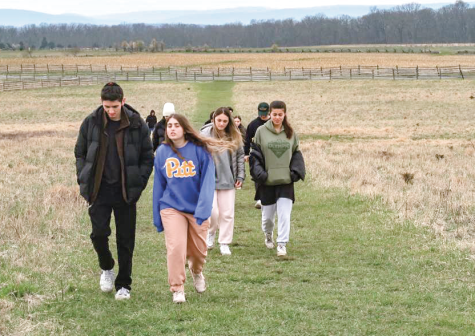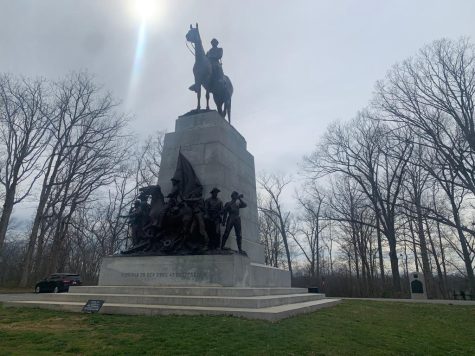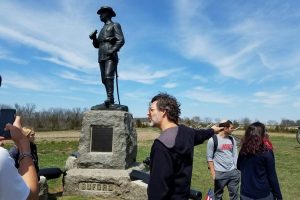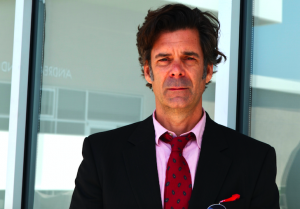A symbol that can’t be separated from its history
On school Civil War trip, walking in the footsteps of Confederate soldiers didn’t change the meaning of their flag
BP Photo by Evan Beller, BP Graphic by Eli Weiss
REFLECT: Junior Molly Menashe reacts to Confederate monuments she saw on the Gettysburg battlefield following Dr. Harris’s SAS Civil War trip.
May 11, 2022
“Heritage not hate.” That expression glared at me from a shelved mug in a Gettysburg souvenir shop, in an image that will remain ingrained in my memory. Those three words, plastered on many Confederate-themed mementos, are meant to justify the sale and embrace of the Confederate flag. Today, many revere that flag in an effort to honor their ancestors who fought and fell under it, regardless of their motives for engaging in the war. Others fly it to elevate historic pride and resistance.
The normalcy of Confederate flags in Gettysburg – as bumper stickers, on t-shirts, or waving on rooftops – both shocked and disturbed me. During the Reconstruction Era, part of the effort to rebuild the country included forgiving Confederates’ inhumane actions and embracing the Confederates wholeheartedly as Americans. Because society was desensitized to the Confederate flag, instead of vilifying or shunning it, the flag remains prevalent and even normalized today.
As part of those same reconciliation efforts, the U.S. government constructed monuments, apportioned to equally represent both the Confederate and Union war efforts. Shalhevet’s current SAS Civil War class, as well as students who took the course last year, explored Gettysburg’s monuments for five days just before Passover.
Walking through the battlefield, we encountered dozens of the 1,300 monuments and memorials in the Gettysburg National Park, such as the Pennsylvania, 12th New York Infantry Regiment, and James Longstreet monuments. On the first day, perched atop a 5-story watchtower, Dr. Harris oriented us to the hills, orchards, and roads of the battlefield, giving a new dimension to the 2D maps we had previously studied.
We learned that the monuments not only serve to honor soldiers’ memories, but were also designed to present a particular narrative of the war and mold public memory – in particular, the narrative of reconciliation and shared nationhood that became prevalent during the Reconstruction Era.

We toured the Jennie Wade House, the home of the only civilian casualty during the battle, to deepen our understanding of how the Gettysburg population was affected.
To personify the victims of the war, each student carried a “pocket soldier,” or a small card with a portrait of an individual soldier, identifying him and noting personal details about his life. Although unsettling, marching through the muddy battlefield, following the path that Confederate troops trekked while under fatal Union fire, animated my perception of the battle.
A ghost tour through a desolate orphanage – supposedly “haunted” – that was active during the Civil War, revealed the commercial interests of Gettysburg, where many attractions cater to tourists.
And finally, overlooking the battlefield, towering 41 feet above us was Robert E. Lee, the distinguished Confederate General, positioned gallantly on a warhorse with statues of his fallen soldiers below. Despite its impartial name – “The Virginia Monument” – and its lack of Confederate symbols, this one proved to be deeply controversial and led to tense class discussions.
Personally, I was immediately repulsed by it. This larger-than-life tribute to Lee, who is mounted on a regal horse standing on a marble pedestal, depicts him as a war hero. To me, this sculpture is akin to glorifying the Confederate cause.
Some argued that the statue should be preserved as part of the commemorative landscape of Gettysburg because it conserves the public’s memory of the famous battle. They claimed that the monument is vital to the national park because its existence demonstrates the way the United States prioritized rebuilding the nation following the war, emphasizing the “Americanness” of all – even prior Confederates.
Others maintained that the monument is entirely separate from the Confederate cause, objectively memorializing a prominent figure in history and marking a nationally significant event. Therefore, they argued, it must remain on the Gettysburg battlefield, which acts as a museum to preserve and relay the complete story of the Civil War.
I disagree. This monument shouldn’t remain in a government-funded park because it glorifies oppression of the Black population, and every American deserves to feel respected, not marginalized, in a public space.
To me, it is impossible to separate Robert E. Lee and his soldiers from the inherently racist institution that they fought to uphold. Their sacrifice to the Confederate cause supported the systematic exploitation and dehumanization of Black people.
Still, many insist that the flag under which the Confederates fought is affiliated with the institution of slavery and instead represents the preservation of states’ rights. Others maintain that Confederate flags are flown solely to honor ancestors’ sacrifices and as a symbol of heritage – as they say, “heritage not hate.”
But to me, this “heritage” and history is hate. While I don’t deny that the Confederate flag has been used to commemorate individuals who lost their lives, I will never be able to separate it from the suffering and persecution it perpetuated, all at the expense of Black Americans.
Even today, the Confederate flag is used as an emblem of white supremacy, symbolizing bigotry and promoting the marginalization of Black and other minorities, and therefore it can never be impartial. To me, a prominent Robert E. Lee monument shamelessly standing in a national park normalizes and validates the sale of Confederate memorabilia, which further fosters animosity and advances the subjugation of Black Americans.
Although used in different ways and contexts, both Confederate flags and swastikas have historically represented racially targeted brutality, and to this day are utilized as tools of intimidation and belittlement, often representing white supremacy. So, I can only imagine the bone-chilling fear that paralyzed my kippah-wearing classmates when they stepped foot into a seemingly ordinary pawn shop on Gettysburg’s Main Street, only to find it adorned with Nazi trophies, including a Nazi helmet, swastika pennants, and a full KKK robe displayed on the wall.

Although I myself didn’t go in, it pains me to imagine the pits of uneasiness and alarm churning in my friends’ stomachs as they eyed the doors, calculating a discreet departure from the shop, feeling unsafe purely because of their religious identity. And still, I can’t help but think about the Black people who experience a similar fear and alienation every time they see a Confederate flag.
Because we as Jews know what it’s like to be haunted by a traumatic past and still targeted today, we should be allies to other vulnerable groups and together endeavor to obliterate bigotry. So, we must heed the Black community’s cries when they speak out against the normalized use of the Confederate flag in order to ensure that no human being feels marginalized.
Although I remain steadfast in my opinion, my experience in Gettysburg and throughout Dr. Harris’ Civil War course not only taught me more than I ever expected to learn about the details of a war, it also enlightened me to the inherent value in examining history from multiple perspectives. My views have been challenged by peers through meaningful dialogue, pushing me to expand my thinking and aim to view history objectively.
Throughout the trip in Gettysburg, I felt burdened by the fact that I was standing exactly where immense bloodshed and tragedy took place. Grappling with that notion while touring the site of the momentous battle opened my eyes to the true weight of what occurred where I stood – the fight over freedom versus oppression. While I heard many opinions, my deepened comprehension of the battle cemented my initial perceptions regarding Robert E. Lee statues and Confederate memorabilia. The idolization of any of these, which to this day are used to uphold xenophobia, should never be tolerated.

















Gary Freedman • Jul 3, 2022 at 10:42 pm
Well written. And certainly valid points. My great great grandfather lost a leg at Gettysburg and from his letters, he would have agreed with most of what you said. Of course as a young soldier in the Union Army recuperating in a hospital, he didn’t have a very positive view of his enemy. That being said, it’s always best to get a 360-degree view of such a historical personality as Robert Lee. For such a view, I recommend reading about the famous 19th-20th century sculptor Moses Ezekiel, a Jew and a soldier who served under Lee. It was Lee in fact, who encouraged a young Moses to pursue his dream of being a sculptor.
https://www.amazon.sg/Moses-Ezekiel-Soldier-Renowned-Sculptor/dp/1575101319
–Gary Freedman, Singapore
Tom Kopczak, Greensburg, Penn. • May 27, 2022 at 6:30 pm
It’s obvious that your history teachers have done a poor job explaining the War Between the States, as even the term “Civil War” is incorrect. While there are many books I could recommend, I would start with “Robert E Lee’s Orderly: a Modern Black Man’s Confederate Journey” by Al Arnold.
— Tom Kopczak, Greensburg, Penn.